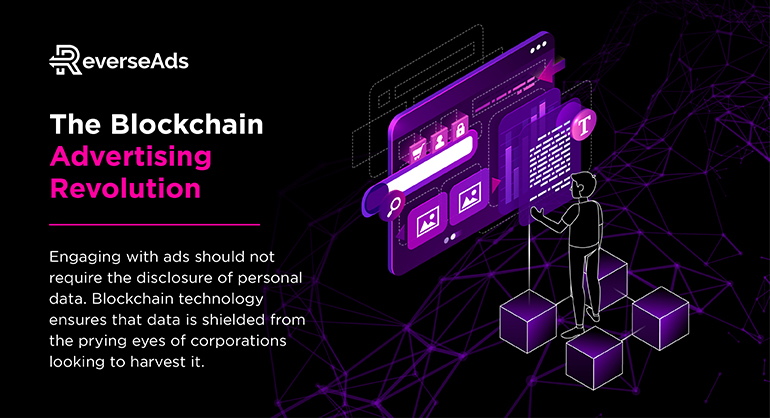The Blockchain Advertising Revolution

Don’t feel like reading? Listen to this blog instead
Engaging with ads should not require the disclosure of personal data. Blockchain technology ensures that data is shielded from the prying eyes of corporations looking to harvest it.
Your data should be just that… yours.
Somewhere on the path to mass digitization, big tech barged in and started claiming the right to monitor, collect, and sell user data. When this transfer of power occurred, consumers and business owners capitulated because of the short-term benefits that data collection seemed to provide.
Now in 2021, the nature of the internet is changing, and blockchain technology is on the cusp of disrupting most industries. This makes it the perfect time to restore balance, and reclaim the ownership of our data from big tech. We achieve this by harnessing the emerging power of blockchain and the distributed web, and combining it with cookie-less keyword algorithms.
The Traditional Approach
Traditional digital advertising allows for ads to be placed across the open web. When a user clicks on this ad, they are directed to an open web landing page. This landing page is hosted by a cloud service provider, allowing for user data to be harvested by the owner of that browser and the cloud service provider.
This process worked great for a long time. It allowed businesses to advertise their products while collecting data on consumers to continually improve ad campaigns. Traditional open web advertising is scalable, as you are operating outside of walled gardens, and across the vast open web. But being that these landing pages are hosted by a cloud service provider, users lose control over their own data. Ultimately the browser owner is claiming rights to your personal information and sharing it with corporations like Google and Amazon.
This functionality sheds a light on why 46% of consumers feel they’ve lost control of their data1. The trend is now moving towards solutions that prioritize data privacy, as 84% of Americans think that the risks of data collection outweigh the benefits.
The Future of Advertising
The solution can be found in blockchain and distributed web advertising. This technology allows for ads to remain on the open web. The primary difference is that ads direct users to a landing page hosted on IPFS distributed web. Users are no longer landing on websites hosted by cloud service providers, which is keeping their data safe.
This IPFS distributed web landing page disperses data across the distributed web, which is decentralized. This way, no cloud company is collecting the data. Similarly, the browser is unable to collect data from the blockchain. This is how ReverseAds is returning data ownership to the people.
Many businesses and media buyers might look at this solution and assume that it is less effective than traditional advertising, as data helps optimize campaigns. However, this is not the case. Advertisers are still able to collect the relevant data through the use of Pixels. The difference being that this data is never shared with the browser or cloud hosting company, who act as middle men and should not be harvesting data in the first place.
Blockchain and distributed web advertising utilizes the scale of the open web for maximized distribution channels, while simultaneously allowing users to maintain ownership of their data. Minimal information is shared with the client based on campaign level engagement with keywords. This keyword data does not include any personally identifiable information and provides enough information for advertisers to optimize their campaigns in real time, ensuring they are delivering ads to high intent buyers.
Engaging with ads and researching future purchases should not require the disclosure of personal data. Blockchain technology ensures that data is shielded from the prying eyes of corporations looking to harvest it. ReverseAds is pioneering this migration and returning data to its rightful owners. This is part of our larger mission to break the chains of big tech and return the power of the internet to the people.





